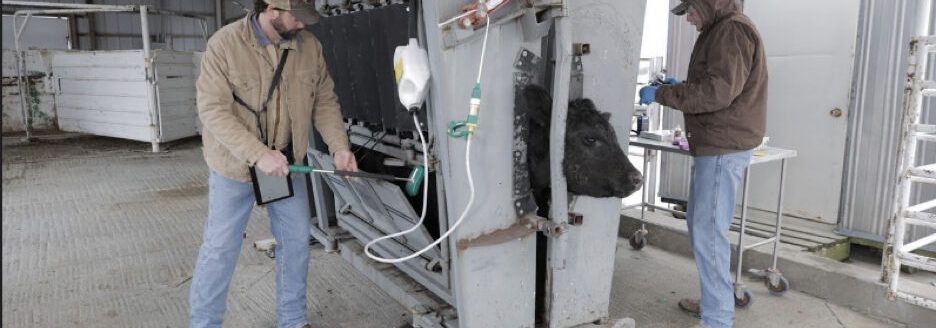If you have treated a sick calf or purchased a flea and tick collar for your puppy, you probably have done business with the Kansas City Animal Health Corridor. In fact livestock producers and pet owners around the world could say the same thing, such is the reach of the corridor.
The KC Animal Health Corridor, established in 2006, stretches from Columbia, Missouri, to Manhattan, Kansas. The corridor is unique for many reasons not just for this region but around the world.
No. 1: Growth
The steady and continued growth of the corridor is one reason. According to the KCAHC 2018 media brief, the corridor is home to 300 companies, which support 20,000 jobs specific to the animal health industry. This represents 56 percent of the total worldwide animal health, diagnostics and pet food sales.
That growth can be attributed to the fact that the corridor has been an effective incubator for new companies.
“The corridor provides a nice regional collective of all the animal health companies and supporting firms to help businesses network and grow our industry together,” said Karthik Ramachandran, vice president and co-founder of Likarda, LLC. “As a startup or small business, the corridor provides assets in R&D, fundraising and expertise from consultants, law firms and marketing firms that can all help a small business enter and grow within this industry.”
“When we founded Likarda in 2012 in Kansas City, many animal health executives and consultants, whom we reached out to for mentorship, provided us with an understanding that an opportunity existed for Likarda to enter the animal health space,” Ramachandran said. “Being located in Kansas City allowed us to seek funds to start our business and with costs being lower in the Kansas City region, we were able to grow our company and hire the right team.”
“Starting a company in the corridor not only provides you a network that is within reach but also allows you to better utilize your funds with its great cost of living and the various state incentives and programs that exist to support innovations,” Ramachandran said.
Since it’s inception 60 new companies have relocated to the region. These new companies represent over $200 million in new payroll and over $1 billion in new capital investment.
No. 2: Global importance
Although the corridor is a regional effort it has global importance. There are currently 20 active projects in the pipeline that represent companies from the United States, England, Germany, Australia, Canada, South Korea and China.
According to the 2018 media brief, the majority of the new projects in the region are coming from companies who do not have a presence in North American but who find that Kansas City is a good fit because of the assistance provided to them from the corridor or from U.S. based companies who are expanding. In addition to the countries mentioned above, companies firm New Zealand, France, India, Belgium and Ireland are represented in the corridor.
“The corridor helps connect the college and our region with the global marketplace in a way that is beneficial to our mission and to the health of the animals under our care,” said Dr Carolyn Henry, Dean of the College of Veterinary Science at the University of Missouri.
No. 3: Inclusion benefit
Even well established companies benefit from inclusion in the corridor, according to Scott Bormann CEO Merck Animal Health.
“The corridor affords Merck Animal Health opportunities to engage and lead in imperatives, alongside other industry leaders, that impact our customers and industry and all those who depend on a healthy and sustainable food chain,” Bormann said. “The corridor represents a collective industry voice on all issues impacting animal health regionally, nationally and even globally. It helps drive industry engagement and workforce development while also representing the animal health industry on key policy issues, advances and innovations.”
“As the animal health industry continues to grow in importance and its role in supporting America’s food chain remains critical, the corridor will continue to be a leading voice of the industry.”
No. 4: Midwest location
The corridor is anchored at the eastern edge by the University of Missouri and on the western edge by Kansas State University. Both of these universities are home to colleges of veterinary science that have benefited from the support of the Animal Health Corridor. The 300 companies in the corridor represent the largest concentration of animal health companies and service providers in the world. This includes biotech innovation labs, research farms, ingredient suppliers and manufacturing facilities.
“The KCAHC provides the colleges with access and insight to industry expertise proximate to our university, facilitating extracurricular opportunities that strengthen industry career awareness and planning for DVM and graduate students,” said Dr. Bonnie Rush, dean of the School of Veterinary Science at K-State.
“Leadership of the KCAHC is committed to succession training for development of future industry leaders,” Rush said. “They have taken intentional steps to assure diverse populations have access to professional development activities. In addition, they have invested time and resources in mentoring for young scientists and entrepreneurs with great ideas.”
No. 5: Magnet for talent
Craig Wallace, CEO of U.S. Operations and North America Pacific Zone director for CEVA Animal Health, said the corridor is an enormous asset for the region and is a magnet for the best and brightest talent in the world.
“We do not have to work as hard to recruit top talent,” Wallace said. “They are already here or potential employees will move here to be part of the animal health community. The abundance of jobs means we do not lose young people from our region.”
Much has changed in the animal health sector since 2006 but the unique characteristics of the corridor have not changed. It still leads the world in animal health investment and innovation.
Doug Rich can be reached at [email protected].



